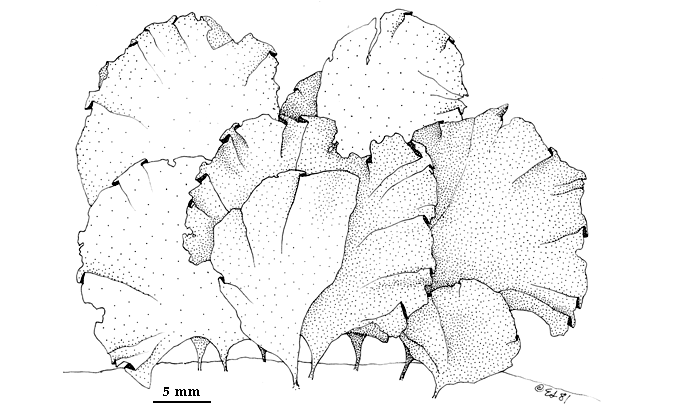Ulva californica
WilleKey Characteristics
- Short, tufted wedge-shaped, translucent blades in southern California
- Long, broad blades in northern California
Image Gallery (click for more)
Database links
- Blue markers: specimen records
- Yellow marker: type locality, if present
- Red markers: endpoints of range from literature
View map from the Consortium of Pacific Northwest Herbaria
Notes: Broadly distributed on west coast; confirmed by DNA sequence from British Columbia, Canada (Saunders & Kucera 2010, Hayden & Waaland 2004), Washington, Oregon (Hayden & Waaland 2004), California: Humboldt Co. (see photo of specimen), Monterey Co. (see photo of specimen), San Diego Co. (Hayden & Waaland 2004) ; Ireland and Scotland, UK (Loughnane et al. 2008, Hayden & Waaland 2004), Yellow Sea (Kang et al. 2014), Japan (Kawai et al. 2007, Ogawa et al. 2013), North Adriatic Sea, Italy (Wolf et al. 2012), temperate Australia (Kirkendale et al. 2013).
Status: Ulva species are difficult to identify to species; this species is difficult to identify in the northern part of its range. Confirmed by DNA sequence from British Columbia, Canada (Saunders & Kucera 2010, Hayden & Waaland 2004), Washington, Oregon (Hayden & Waaland 2004). In California: Humboldt Co. (see photo of specimen confirmed by DNA), Monterey Co. (see photo of specimen confirmed by DNA) to La Jolla, San Diego Co. (Hayden & Waaland 2002, 2004). Worldwide: Ireland and Scotland, UK (Loughnane et al. 2008, Hayden & Waaland 2004), Yellow Sea (Kang et al. 2014), Japan (Kawai et al. 2007, Ogawa et al. 2013), North Adriatic Sea, Italy (Wolf et al. 2012), temperate Australia (Kirkendale et al. 2013).
Habitat: Upper-low intertidal, subtidal
Life History: Alternation of isomorphic phases, with the sporophyte producing quadriflagellate zoospores and unisexual gametophytes producing biflagellate anisogametes; male and female gametes capable of parthenogenetic development (Tanner 1986; Chihara 1969a; Smith 1947).

Illustration from DeCew's Guide to the Seaweeds of British Columbia, Washington, Oregon, and Northern California

Ulva Linnaeus 1753
Thalli membranous blades, broadly expanded, distromatic, mostly without hollow margins. Blades annual, mostly without stipe; rhizoidal processes from multinucleate lower cells extending downward between blade margins forming usually perennial holdfast. Cells of blade mostly uninucleate. Chloroplast single, laminate or cup-shaped, usually on outer face of cell, with 1 to several pyrenoids. Sporangial and gametangial thalli usually morphologically similar; fertile areas marginal or terminal; zoospores quadriflagellate. Gametes biflagellate, isogamous or anisogamous. Zygote germinating without dormant period.
Ulva californica Wille
Wille, P.B.-A., 1895-1919 [l899]: no. 611; Setchell & Gardner 1920b: 2264; Doty 1947a: 11.
Blades mostly 1.5-2 cm tall; cuneate to ovate or reniform, commonly much crisped, with broad attachment or slender stipe; membrane 30-35(60) µm thick, commonly much thicker near base; cells in surface view irregularly polygonal with rounded corners and irregular arrangement or in distinct rows; (5)10-15 mm diam., 1-1.5 times as long as diam. anticlinally; chloroplast with 1 or 2(4) pyrenoids.
Usually in dense, turflike stands atop rocks, occasionally epiphytic, midtidal to upper intertidal, Ore. to I. Magdalena, Baja Calif.; formerly common in S. Calif., seemingly rare or absent in C. and N. Calif. Type locality: La Jolla, Calif.
"Gomontia polyrhiza," which may be a stage in the life history of species of Ulva, is described on p. 120.
Excerpt from Abbott, I. A., & Hollenberg, G. J. (1976). Marine algae of California. Stanford University Press, Stanford, California. xii [xiii] + 827 pp., 701 figs.
Notes: This species has a larger geographic range and much more morphological variation than as originally described. Form ranges from the short turfs (upper intertidal) to long, lanceolate blades (low intertidal, subtidal). Ulva angusta Setchell & Gardner and U. scagelii Chihara are synonyms (Tanner 1986, Hayden & Waaland 2004). Tanner (1986) described the unique development of U. californica, which forms a germination tube and extensive basal system instead of direct development as in other species (see illustrations). He also demonstrated that its morphological variation is related to temperature, with smaller, clustered blades at warmer temperatures, as in southern California, and larger, longer blades in cooler waters north of Point Conception (see illustrations). Blades in areas exposed to wave action tend to be shorter and thicker than those in sheltered areas (Tanner 1986). The description in MAC fits southern California specimens.
CRYPTOGENIC
Vertical Distribution: Upper-low intertidal, subtidal
Frequency: Common
Substrate: Rock, mussels (Mytilus californianus)
Type locality: San Diego, California
